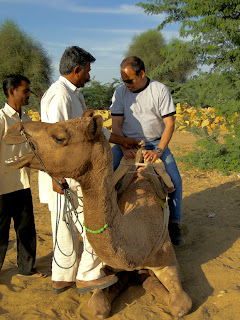The Thar Desert stretches over most of Rajasthan, and into parts of Pakistan and Afghanistan. It's the second-largest desert in Asia; only the Sahara is larger. Much of what we saw was scrub desert, with low shrubs and sparse grasses struggling to survive with a minimum of water. But, if you're willing to give it a try, you can get out onto the dunes by camel. We were willing, so one afternoon found us heading out to the camel camp.
Much to my embarassment (having spent a number of years riding some very tall horses), I discovered that camel riding falls into the same category for me as river rafting -- so happy to have done it once, but I have no desire to do it again.
 |
| The first stage of bringing the camel down to "human level". |
The most difficult parts of the camel ride come at the beginning and the end. The camel walla pulls the camel downward by pulling on a rein attached to a bone that goes through the nasal septum of the camel. Naturally, the camel is a little annoyed by this process, so he bellows and roars a bit, but eventually falls first to his knees and then brings his rump down into the sand with a thump. At that point, it's pretty easy to climb on. Once you feel secure in the saddle, you are instructed to hang on and lean way, way back. The camel then reverses the getting down process with a series of two jarring jerks upward, first bringing up his rump (which makes you want to fall forward) and then straightening his front legs (which throws you backward). It's a bit nerve wracking. Then, just as you feel quite secure in the saddle, you look down to discover that you are suddenly sitting about eight feet up off the ground.
 |
| Vish, getting instructions on how to survive the rest of the mounting process. |
We both made it up to the standing position without mishap and started off into the desert. The motion of an ambling camel (they really don't just "walk") is actually a lot like being on a horse -- kind of a rocking chair motion that is really kind of pleasant -- if only you weren't so high up and wishing you had stirrups.
About fifteen minutes into the ride, I could see that my camel was going to brush too close to a small tree. Not wanting tree branches in my face, I reached up to push it aside, only to discover that it was a thorn tree -- a thorn tree that didn't want to let go of my hand. Finally, though, it did and we continued on our way as I added my blood to the designs of the saddle cloth.
Eventually, we reached a lovely crest of dunes where the camel wallas tied our beasts to a tree where they could graze on some berries. We also grazed on the succulent little red berries, spitting the pits into the surrounding sand, and waited for the sun to creep down toward the horizon.
 |
| One of the camel wallas with his camel, silhouetted by the setting sun. |
With the sky darkening, draining the color from an already pale landscape, we remounted and headed back to the camel camp. As other camels drifted back to the camp, the plaza there was gradually ringed by about 20 or 25 fellow riders. At one end, several musicians played and sang. Dinner was served and we were treated to a show of Rajasthani music, dancing, and fire.
 |
| The musician on the left is playing a Jew's harp to the accompaniment of the tabla. |
 |
| This very talented dancer is stroking his arms with burning torches. He also ate and breathed fire. It was pretty spectacular! |
Well fed and well entertained, we opted to return to our hotel in Jaisalmer, although we could have stayed in the little cabins at the camp. But we knew we had a very long drive ahead on the next day and there would be a generous breakfast available at the hotel to see us on our way.
No comments:
Post a Comment